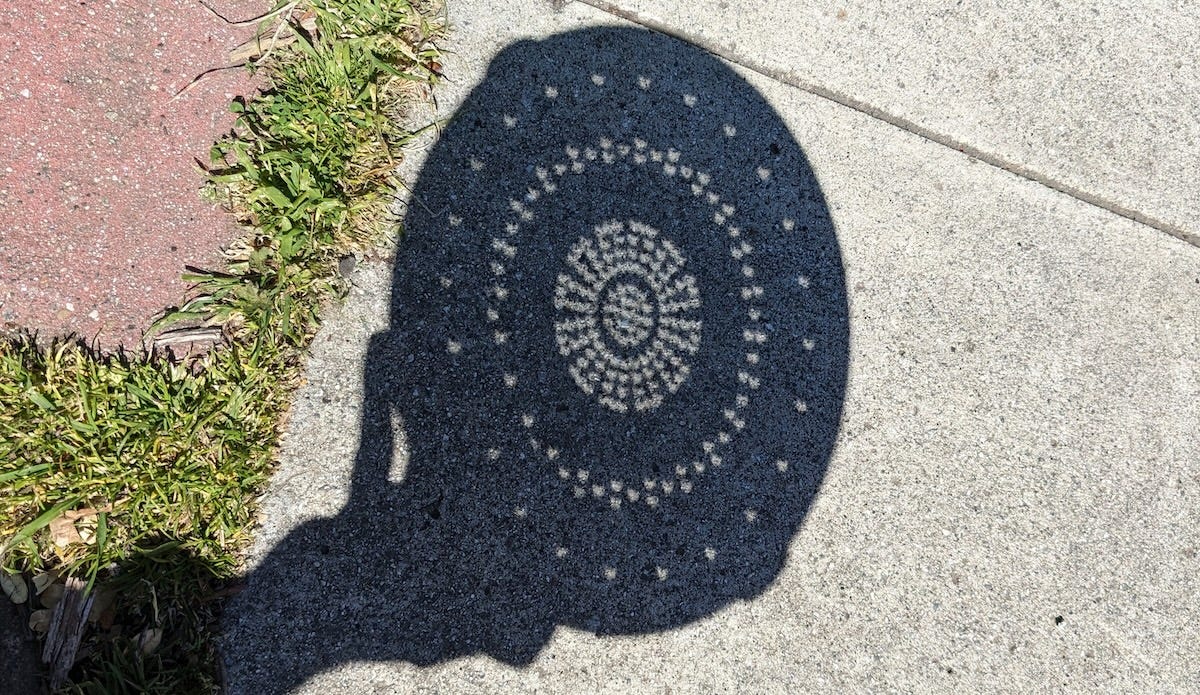Notes from a totality
☀️🌑🌎 What a solar eclipse can do to you
Today’s solar eclipse was far from total where I was. In Northern California, the Moon blocked at most about one-third of the Sun. Of course, I watched it, with Karen, sitting in our driveway with a colander (to make a constellation of pinhole-camera crescent Sun images on the ground). We chatted with our neighbors, one of whom lent us his eclipse glasses. We tried to convince the recycling truck driver to take a look, but he said he was too nervous.
I am a little sad that I couldn’t be back home in Ohio, where I grew up. My hometown, Bowling Green, was scheduled for about 4 minutes of totality today — although clouds might have obscured the sight. I have been thinking about returning for this event for several years now. But my life circumstances aren’t favorable for such a trip right now, so I settled for a partial eclipse from here.
I thought back to the 2017 total eclipse, which I watched from Oregon, along with my family, on a trip that my late father had planned years in advance.
So I wanted to share an essay (with some embedded haiku) I wrote about the experience.
What was your experience of the eclipse? Write back or drop a comment on this post — I’d love to hear from you.
Instead of sunrise and sunset, Buckminster Fuller suggested we use “sunsight” and “sunclipse,” words that make explicit what happens in a more accurate, heliocentric view of things. The Sun does not move; we, carried along on the surface of the Earth, turn away. The Sun didn’t go anywhere. It became hidden, for a while, behind the Earth. Then, some hours later, we turn back into the light, and the Sun appears to rise as it becomes visible, bit by bit, over the limb of the very planet we stand on.
By this way of thinking, a solar eclipse is a special instance of sunclipse. Instead of the Earth, it’s the Moon eclipsing the Sun. The fact that it appears to do so rarely, and that it does it so perfectly, with the disc of the Moon almost exactly matching the disc of the Sun, has to do with the relative sizes and distances of the three bodies. A perfect celestial coincidence.
It’s easy to imagine a different solar system in which eclipses of the Sun by our Moon never happen or happen constantly; where the apparent size of the Moon is much smaller or much larger than the Sun. Nevertheless, here we are, on this particular planet, where eclipses of the Sun by the Moon happen rarely enough and locally enough that they are worth seeking out.
As I stood there in a field adjacent to a motel parking lot in far eastern Oregon, watching the August 2017 eclipse happen with my wife, my children, my father and my stepmother, this experience of celestial motion touched me deeply. Just how deeply would not become apparent for several years. But that moment of witnessing the Moon covering up the Sun, plunging us into almost-night, caused something to start moving in me.
Like a struck bell, I experienced a vibration that continued long after the Sun returned to view and the black disc of the Moon slid away and disappeared into the blue light of day.
Annie Dillard has written about the experience of totality, when “the sky snapped over the sun like a lens cover.” She writes that at that moment, she left the world of the living and entered a dead universe, her mind light-years distant, looking at her husband through the eyes of ancient ones living in the Euphrates River valley harvesting einkorn with stone sickles. She wrote: “It was all over.”
Unlike Annie Dillard, I did not lose my mind right away. In my case, it took time.
…
Dylan’s newsletter has moved to a new site! To continue reading this post, please click here:




There is a lot to relish in these moments you paint so vividly. The scenes by the pool, the a-ha’s and reflections, the grandness of all this and the glimpse, hint of what’s to follow. I cannot wait to follow along… !! <3 Like the eclipse… and what has been said in a previous comment, there is little other way to describe this writing outside of: magic! TYSM for sharing this part of your world.
Gorgeous, Dylan. 🌚🌞